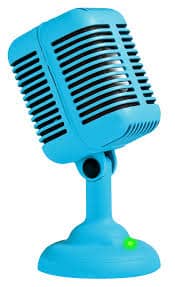Most musicians learn very early that microphones are the most critical part of a recording and live performance. They can make or break a recording or live performance. There are 3 basic types of mic generally used today. What are the 3 Types of microphones?
- Dynamic Mic-simple construction, economical, rugged-handle high sound levels-used in Live music.
- Condenser Mic-wide dynamic range-flat frequency response-small or large diaphragm used in recording-require battery power.
- Ribbon-Figure 8 Polar pattern-natural mics used to capture more color & ambiance
There is a microphone for each process in the studio and on stage. You don’t really have to know what the mechanics and science behind each type is. You only need a basic understanding of how they are unique and which one is best used in different situations.
There are 3 common Types of Microphones in the Industry
- Dynamic Microphones
- Condenser Microphones
- Ribbon Microphone
Dynamics Microphones are called the workhorse mics in the music industry. They are durable and sturdy. They are the mics you see in the school plays and at the Park for the summer concerts. They have no internal power or moving parts that can break and can hold up to colder weather and moisture in high humidity on those damp humid nights in August during the outdoor concerts.
How Does a Dynamic Microphone Work
Dynamic microphones use the electromagnet principle that says when a magnet is near a coil of wire it generates an electric current. The Dynamic microphone uses a magnet and a coil of wire to produce an audio signal.
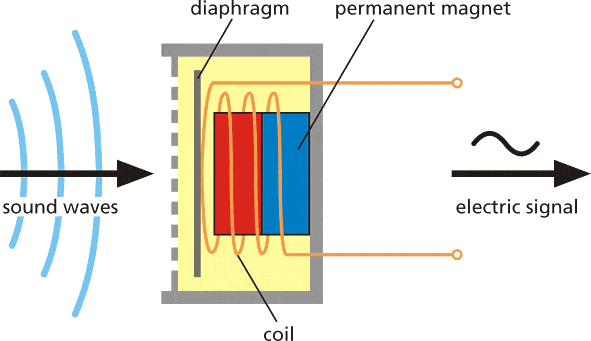
Dynamic microphones can be used for different applications. They are great for live stage vocal and back-up vocal microphones. They are good for recording and live amplifying of guitar amps and drums. The mainstream standard Dynamic microphones of the last 50 years have been the Sure 57 and the Sure 58.
They handle all the noise of a live hard rock sound and rarely give up and feedback. I’m from the garage band era of the ’70s and 80’s and bands back then only used 2 mics to get going and that would be the Shure 57 & 58.
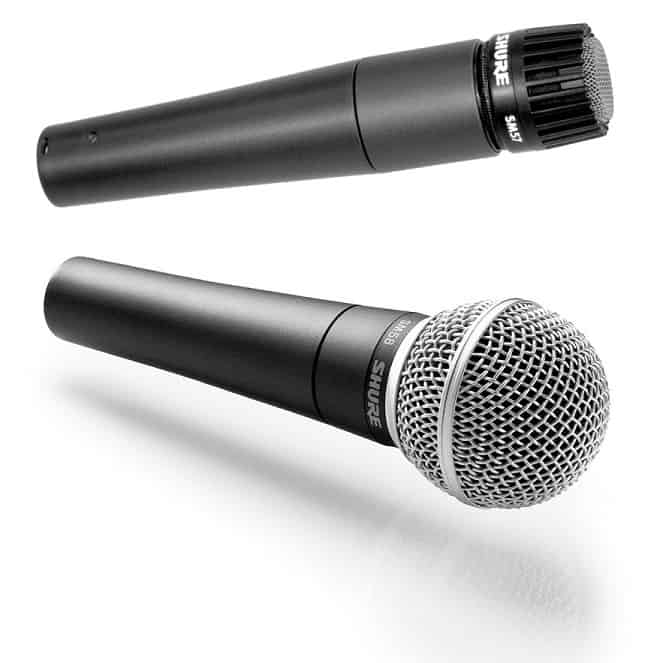
How Does a Condenser Microphone Work
Condenser Microphones work as capacitors do. They store energy to convert acoustic energy to electrical energy. Condenser mics require power from a battery or an external source.
It carries a stronger audio signal than a Dynamic mic and they are more sensitive and are known to be more responsive than Dynamic mics. This quality makes them well suited for capturing the subtle nuances of sound that escapes other types of microphones. Condensers are more fragile and more expensive and are prone to distort.
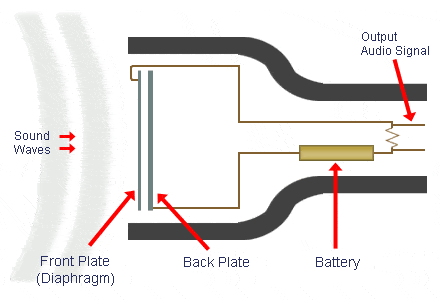
Condensers are ideal for recording especially acoustic guitars and vocals. Most acoustic instruments use Condenser microphones when recording. They have a wide range pattern and pick up the softer tones. I used all condensers on my stringed instruments and would save money to get the exact one I needed for recording mandolin or fiddle. It’s not unusual to pay $10,000 dollars for a studio Condenser mic from Neumann.
According to Neumann Microphones; Due to its extremely low mass, the diaphragm of a condenser microphone can follow the sound waves more accurately than that of a dynamic microphone with a (relatively) heavy moving coil attached.
Condenser microphones, therefore, offer superior sound quality. Of all microphone types, condensers have the widest frequency response, and the best transient response (transients are fast bursts of energy, e.g. the attack of a drum or the “pick” of an acoustic guitar). Also, condenser microphones usually offer much higher sensitivity (i.e. output) and lower noise than dynamic microphones. Here is a Neumann in the mid-price range a beautiful Condenser Mic for your Studio Recordings Neumann KMS 104 Plus Condenser Microphone (Black)
How Does a Ribbon Microphone Work
Ribbon mics are for the recording connoisseurs who are not on a budget. The mics are popular for those who want a vintage-sounding vibe to their recording.
Ribbon mics have an uncanny ability to record an entire room beautifully, record higher notes associated with woodwind or strings accurately, and relay more ambient sounds.
These features make these microphones very popular with those who want to record a wide range of acoustic instruments professionally. They are very sensitive and can be extremely costly.
These features make these microphones very popular with those who want to record a wide range of acoustic instruments professionally. They are very sensitive and can be extremely expensive.
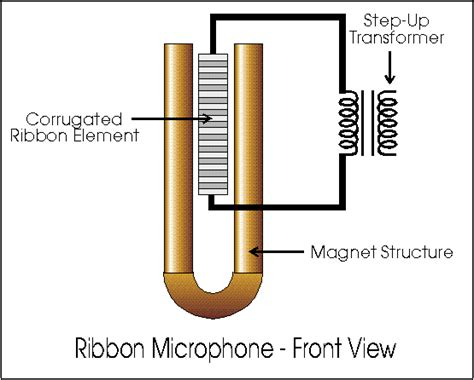
Ribbon Mic Diagram
Simply put microphones convert energy from one type to another. Also called a transducer. The acoustic sound energy which is sound waves is converted to electrical energy or an audio signal.
Different types of mics convert the energy differently but they all perform this basic function no matter what type of microphone you are dealing with.

The Basic Workings of a Microphone
The mic contains a Diaphragm that vibrates when sound waves hit it. This causes other parts in the mic to vibrate and these vibrations are converted to an electrical current which in live and recorded music becomes the Audio Signal.
At the end of this transducer is a Speaker that is also a transducer. The Speaker converts the Audio Signal or the Electrical energy back to Acoustical energy so we can hear the input sound. The reverse of what the microphone does.
The Types of Conversion Technology used in a microphone will determine what type of microphone it is. In other words, how the mic converts the electrical energy to audio energy determines what kind of microphone it is.
The most common technologies in mics are Dynamic, Condenser, Ribbon, and Crystal. Each type is suited for different applications and specific situations.
The signals or electrical energy that microphones put out are very small and measured in millivolts. Before the signal called mic level can be used it needs to be stepped up and amplified to create a line level. typically line level is measured at 0.5 to 2 volts. This is the standard signal today used in audio processing equipment and other electronic equipment like CDs and tape machines.
The important thing to remember is that the signal coming out of the microphone needs to be boosted up to work with other electronic sound equipment. There are different locations where the signal can be boosted. The microphone can be run through an amplifier called a line amp or the in the sound mixer where each channel has a dedicated amplifier.
Attenuators can evenly adjust the amplification of a group of mics to an even line-level or some microphones have a built-in amplifier that will boost the signal to a high mic level or a line level.
also known as a ribbon velocity microphone, is a type of microphone that uses a thin strip of aluminum or nanofilm of electrically conductive ribbon placed between the poles of a magnet to produce a voltage by electromagnetic induction. Ribbon microphones are typically bidirectional, meaning that they pick up sounds equally well from either side of the microphone.
They have a look feel and sound quality that is from the earlier days of radio and broadcasting. The advantage of this type of microphone is the light thin ribbon can vibrate and pick up flatter and higher frequencies. Here is a beautiful Mic made by Rodes found on Amazon used in Pro Studios called Rode NTR Premium Active Ribbon Microphone
Microphones and Direction
All mics are sensitive to sounds from different directions. The front or back or both sides and all directions. The 3 types of Directional Microphones are called:
- Omnidirectional Microphoneswhich means that the microphone picks up directions from all sides.
- Unidirectional Microphoneswhich means that the mic will pick up sound from one side only.
- Bidirectional Microphoneswhich means that the mic will pick up sound from 2 sides or both opposite sides of the mic.
When you purchase a microphone you want to know what direction you will be recording from. There are various reasons and situations where you will need to use direction when recording. With each microphone, there is a sweet spot that the manufacturer will include with the mic that will indicate where the best place to record on the mic is. It’s called a polar pattern.
Each mic no matter how cheap or expensive will have this sweet spot diagram that comes with the mic in the box. This will also give the user an idea where room noise and feed-back condition might kick in. You’ll be getting the most quality sound out of the mic that is possible.
Omnidirectional mics might have sound advantages but not necessarily in all situations. If your recording you won’t want background noise coming into the recording from an open part of the mic. Then again if you’re recording a small choir, Bluegrass Trio, or an orchestra. An Omnidirectional mic would work better than a unidirectional in that situation.
If you’re trying to capture sound from one or two subjects then it would likely be drowned out from other noise that the Omnidirectional mic is picking up. This is what you need to consider when buying a microphone. How many subjects are being recorded at one time and at what direction will the sound be coming from?
Cardioid Microphone Definition
Cardioid and Hypercardoid Microphones
Cardioid Microphones are mics that are most sensitive from the front of the mic. The sounds from the side s are picked up at a quieter rate. While the sound from the rear of the polar pattern of the mic is rejected. On the stage and in the studio the singer wants exactly that. No background noise at all.
This gives a vocalist a clean dry vocal experience. If you are looking for a vocal mic for the stage or even in the studio where the sound is controlled you are better off with an Omni-Cardioid microphone. A vocalist should sound dry and close with little or no background noise bleeding into the recording and robbing frequencies and ambiance from the singer.
Aside from the Cardioid patterns, there are a few more worth talking about. Super-Cardioid and Hyper-Cardioid are a mix of Omni and Cardioid patterns that are important in playing and recording acoustic instruments with a small group of say 2-4 players with acoustic guitars.
You can actually control the polar patterns by canceling some sound towards the rear part of the pattern by location of the subjects you want to focus on. This kind of science is not complicated and is very good for live music. If you use the polar patterns of the mic you can trim off some sound in the outer areas and focus more on the front vocalist or lead players.

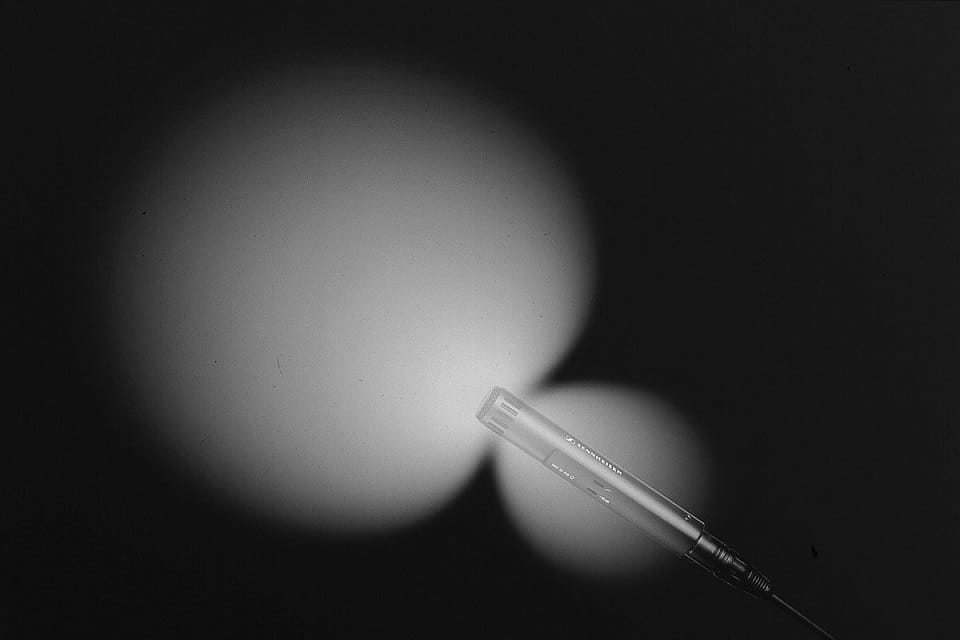
With this pattern above you can see that there is some cancellation in between other Cardioid patterns. The focus on the front and some more in the rear middle with some cancellation in the rear back and sides. This is advantageous in live settings with small groups of the acoustic player on stage and miking drum kits for live playing. We will be going through all those aspects of miking through this blog.
With some types of microphones, the polar patterns are adjustable which means you can adjust your own by selecting Cardioid, Omni, or any of the hybrid patterns and selections that are available.
What is Microphone Impedance
Impedance is an electronic term that measures the amount of opposition a device has to AC current. In this case, it’s a microphone audio signal. If you are like me I really don’t give a hoot what the impedance rating is on the box of a mic but you should know in general what it is. It is the combined resistance on a signal. the Impedance is represented by the letter Z. When you see Hi-Z or Low Z on the microphones box, that means high or low impedance.
Low Impedance is better than High Impedance. High impedance equipment is usually cheap equipment. There are 3 different impedance ratings. Low, Medium, and High, and some mics can select and adjust between the ratings. Low impedance microphone and equipment are always preferable to higher cheaper impedance.
What is Frequency Response
Microphones are built and engineered to work in certain frequencies. If the mic is a vocal mic then those frequencies that are normally involved with a vocalist range will be added while the frequencies not generally involved in the range will be cut out.
A condenser mic that is used for vocalists will pick up everything according to how good the quality is with the EQ of the human voice. These frequencies are amplified or cut with the mic so that the purchaser can compare the quality of each microphone for the price.
A microphone does one thing. It converts sound into an electrical signal that can be amplified, recorded, or transmitted. But, there are a number of different characteristics that make microphones sound different. These characteristics determine a mic’s suitability for a particular application.
Types of Microphone respond differently to frequencies some of those frequencies are amplified and some frequencies will be cut or reduced. This Frequency Response is the most important measurement when it comes down to picking a microphone. This information is represented on a graph that will come with the microphone from the manufacturer.
How to Choose a Microphone

The Shure Anechoic Chamber
A microphone is tested for responses in frequency in a room constructed specifically for this purpose.
The mic is set up in front of the calibrated loudspeaker. Pink noise is played. (If you’re not familiar with the term, pink noise is all frequencies with equal energy in every octave.) The microphone signal is routed into a spectrum analyzer and a frequency response chart is produced.
The Frequency Chart is usually over the 20 Hz to 20 kHz range, which is the range of human hearing. So, how do you read it?

The horizontal numbers in a microphone frequency response chart indicate frequency and the horizontal ones are decibels.
The Frequency Chart is usually over the 20 Hz to 20 kHz range, which is the range of human hearing. So, how do you read it? Again, usually over the 20 Hz to 20 kHz range, and the vertical numbers represent relative output level in dB (decibels). As you look at a frequency chart, you can tell how a given microphone performs at certain frequencies.
A microphone types may be tested for its frequency response to a bandwidth of 20Hz to 20KHz to see what gains it produces at each frequency. A microphone may have a flat response in which it produces roughly the same gain at each frequency, or a microphone have may a remarkable difference in the gains it produces for low frequencies and high frequencies.
A microphone may produce a great gain for bass and a low gain for treble. This is why frequency responses are performed on microphones. If a microphone is going to be used for speech, a voice microphone must have great gain for bass, since the human voice is in the low frequencies. If a microphone is going to be used to record music, it must have great gain from bass to treble, since music normally has all the tones from lows to highs.
A flatter response is desired when a mic produces the same gain for high and low frequencies. This improves the sound of audio where bass and treble play at the same volume for smoother sound quality and response. This is why microphone frequency responses are run.
I hope you enjoyed our introduction to Microphones here at MikingDesign. com. I also hope you learned a little bit through this format. I know I did. During the duration of this blog, we will go over microphone techniques in live and studio settings. We will also cover the placement of microphones for the most common instruments that are used in Popular music and for all genres.
JimGalloway Author/Editor
